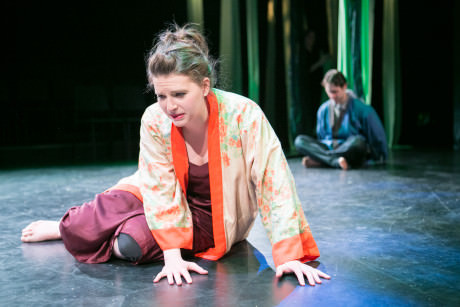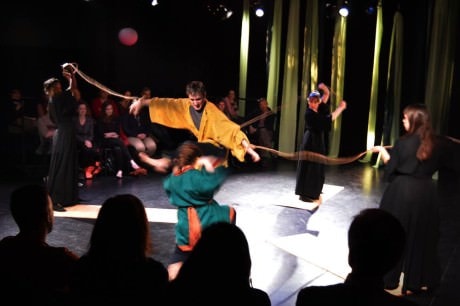The stunning production of Rashomon, directed and adapted by Randy Baker at American University, is set at the City Gate to Kyoto, a court of law, and in a grove in the forest, circa 1100 AD.

This highly ambitious play is an adaptation of a seminal Japanese film by Akira Kurosawa, which has been honored all over the world since its premiere in 1950. The film has has spawned many other portrayals of dramatic events in which there is little or no concensus about the “truth” of events described by various witnesses and narrators, and use flashbacks rather linear narrative development. It’s progeny even includes an American version starring Paul Newman, using western conventions, called The Outrage.
Rashomon opens with a priest, a woodcutter, and a emotionally disturbed peasant taking refuge from a downpour beneath a ruined wooden gate in 12th-century Japan. The priest and the woodcutter discuss the trial of a notorious bandit for rape and murder and are eventually involved in the trial themselves.The events are retold by various participants, including the bandit, the victims, (husband and wife) each describing a contradictory chain of events and alternative views of each other’s motivations, culpability, and attitude toward honor. These various views never really add up to an evolving “truth,” but add layers to the audience’s understanding of the complexity of human experience. lies and defenses. They also call into question the identification of the woman as a victim, a deliberate plot element although politically provocative in this era of notorious rape cases occurring on university campuses.
Baker is fortunate to be working with a very talented group of actors and designers. The main characters are played by Linda Bard (the Woodcutter), Drew Copeland (The Samurai), Nicholas Galatis (The Priest), Kendall Helblig (The Wife), Callie Trawick (the Peasant/Wigmaker) and Patrick Kavanagh (The Bandit).
Kavanagh is a standout, with a malevolent sneer and unkempt greasy hair he projects criminal intent. Callie Trawick comes across as a wild-child, effectively portraying an unsocialized and alienated creature who survives in the forest by robbing corpses of their hair, which she sells for income. Drew Copeland as the Samurai portrays himself at first as an upright citizen-soldier but later as a failed warrier, a naïve captive of the Bandit, and eventually as a husband who cannot forgive that his wife brought him no dowery. It is believable that the drama in the forest has highlighted existing tensions between the spouses that no nostalgic poetry can mend. Kendall Helblig manages to weather a lot of physical violence, sometimes with resistance and alternatively with lustful intensity in a subsequent vignette.
In addition to the human characters in the play there are spectral figures who play secondary roles and sometimes intervene in events, suggesting that the human characters are not totally in control of their destiny. These roles are called Koken, and are ably filled by Bianca Lipford, Ella Beaudoin, and Ivy Rice. These figures sometimes act to restrain, trip or distract the human characters and add another dimension to a play which may or may not aspire to any sort of realism. Likewise the husband’s story is sometimes told through the agency of a medium.
Set Designer Leah Gussoff provides a very effective, minimalist set which is culturally suggestive.The setting of the story is a dark woods, adding to the ominous tone, and minimizing the need for scenery. Most of the design is provided by long drapes abstractly suggestive of foliage. When the action moves to the present day, the primary signifier of this change is the intrusion of a cell phone and some abandoned kimonos.
In the absence of many physical props, Sound Designer Robert Pike and Lighting Designer Nate Collard’s exceptional work contributed so much to the success of the production. And Stage Mangers Rebecca Silva, Erica Pierce, and Kay O’Connor, deserve kudos for their fine work.
Notably, there are amusing contemporary references and explanations such as one character’s description of the mitigating causes of her behavior:”I didn’t have good role models.” And towards the end there is a hug-fest which is strikingly anachronistic. This play has definitely gotten some re-writes to “bring it up to date.”
I enjoyed the elaborate choreography within the play, including the synchronized dances of the black clad spectral figures and a wonderful bit with ropes. Several events are attributed to Fight Choreographer Robb Hunter, who is credentialed and celebrated as the CEO of the theatrical weapons company, Preferred Arms. The hand combat events were rather stunning due to their rapidity and apparent potential for serious injury. However murderous the Bandit’s intentions may have been, nevertheless, the husband, who presumably experienced a fatal injury, is resurrected multiple times during the course of the story. He’s a lucky man!

American University’s Rashomon is a visual treat, and I look forward to seeing future productions.
Running Time: 1 hour and 45 minutes, without an intermission.
Rashomon plays tonight at 8 PM and tomorrow, Saturday, February 21st at 2 PM and 8 PM at American University’s Katzen Theatre – 4400 Massachusetts Avenue, in Washington DC. Tickets can be purchased at the box office by calling (202) 885-ARTS or online.
RATING:
https://youtu.be/sBn4cvHKPUc




